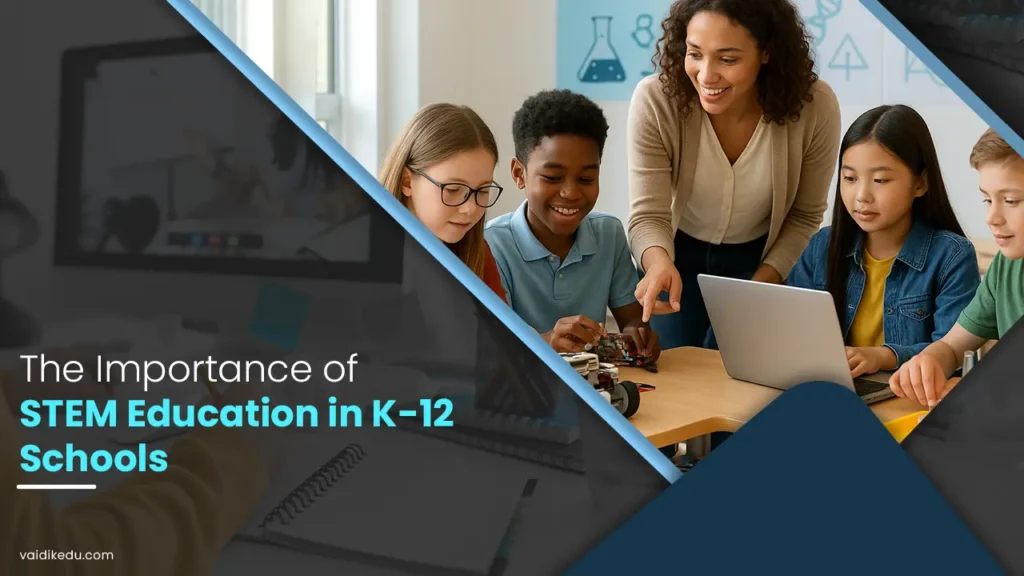STEM education, which stands for Science, Technology, Education, and Mathematics, has been helpful to people in all facets of life in the rapidly expanding world. People’s lives have been made more powerful by technology and innovation, which are used in everything from labor to necessities.
The importance of STEM education is taught to students starting from kindergarten and skillful. Thus, the importance of STEM in K-12 has been highly emphasized over the years.
The upcoming generation is prepared to monitor the technology and tools by enhancing critical thinking skills, sharpening their minds through innovative activities, and grooming problem-solving skills from their early life. STEM education motivates students to be the next inventor and researcher of technology.
Meaning of STEM
The set of concepts about STEM education incorporates the fields of science, technology, engineering, and mathematics into a single field. The emphasis is given to hands-on experiments and projects in which the students will learn to solve real-life problems and encourage them to learn more about technology and its related fields.
In other words, it can be said that STEM is an interdisciplinary curriculum that connects theoretical aspects of technology with their application. In this way, it helps the students to invent new tools that would help the next generation. This level of application is not introduced in the traditional text which can be learned in isolation.
Why STEM Education is Significant in K-12 School
Door To Job Opportunities
With the growth of technology over the years, it has become of utmost importance to equip people especially students with STEM education. This can enhance the global economy which demands more people in the field of STEM.
Most jobs require skills in the STEM field more than in non-STEM fields. Job opportunities in artificial intelligence, data analysis, biotechnology, and other engineering fields require the skills in STEM. Students who have been engaged in STEM education tend to have more opportunities in the future technological fields.
Enhancement of skills
Education in STEM from an earlier stage of students’ lives can enhance skills such as critical-thinking skills, problem-solving skills, and application-level skills. This can improve their involvement in technological and engineering fields in the future.
Critical thinking skills are the most important skills that a student must acquire through STEM education and this can be enhanced through their curiosity and asking questions. For instance, if a person needs to design a robot, they need to think ahead about the process, algorithms, implementation process, etc.
For this, a problem-solving attitude is required. Also, engaging in a STEM field in the earlier years of students’ lives can sharpen their minds and it is useful even in the non-STEM fields. In this way, life skills are learned through the STEM education.
Encourage Creativity
An innovative mind is the basis for the future creation of AI and other technologies. Innovation occurs through bringing creativity into every aspect of life. Education in STEM can challenge students to think outside the books and to see unknown things and patterns from already-known theories.
Students themselves practiced applying the learned theories into action. For this, an imaginative mindset is imparted to the students and given a chance to apply them by giving projects and assignments. In this way, they will learn to be creative. In the technology field, students should learn about designing and codes. This also can bring creativity to the students.
Acknowledging Diversity
STEM creates an environment of accepting diversity and gender equality.
It is observed that at the beginning of STEM education, it was not accessible to all society, especially women and minorities.
They were not encouraged to take part in the projects and skill development courses of STEM. So, implementing STEM for K-12 students can remove the gap of gender inequalities. Regardless of the background and gender, all of the students are encouraged to learn STEM.
Lifetime Learning: Students are allowed to explore more about the technological aspects. This can build curiosity in the students. Since STEM education is more practical, students are interested in learning more, and can make them a lifetime learner.
Learners gain a sense of satisfaction by working on different projects and can enhance their curiosity level by extending their learning years. This will introduce more people to the field of research.
Successful Execution of STEM in School
Experimental Learning:
STEM education is more about practical learning rather than traditional classroom-level studies, where teachers lecture and students are not able to keep up with the teaching. In STEM, each of the students is given value and ideas of each of them are considered or disregarded based on practical application.
Theory is a part of this education but more emphasis is given to the hands-on activities of the students. So, it is indispensable to introduce hands-on activities in the STEM curriculum. Practical skills are the foundation for STEM education.
Building AI-based cars or designing 3D models require practical skills and this can be developed in the students through brainstorming activities in the school.
Introduction of interdisciplinary Studies:
STEM involves multidisciplinary education which involves many subjects rather than focusing on just one subject. For example, the study of renewable energy sources involves physics, mathematics, engineering (for designing), and coding. In this way, for a single topic different subjects are involved. In this way efficiently students can learn many subjects through STEM education.
Improvement in Teachers Training:
To provide successful STEM education, teachers are essential. Programs for professional development should give teachers the skills, materials, and self-assurance they need to teach STEM subjects. This covers curriculum design, practical teaching techniques, and instruction in the newest technology.
Incorporation of All Types of Technology:
A key component of STEM education is technology. To give children access to cutting-edge educational resources, schools should spend money on things like 3D printers, robotics kits, virtual reality, and coding platforms. In addition to making lessons more interesting, technology also gets pupils ready for jobs that include technology.
Collaboration Between Industry And Society:
STEM education can be improved through cooperation with nearby companies, academic institutions, and organizations. Funding, mentorship possibilities, and access to practical STEM applications are all possible through partnerships. For example, to motivate students, STEM professionals can conduct workshops, visit schools, or provide internships.
The Wider Effects of STEM Learning
Beyond just helping pupils, STEM education also benefits society at large. STEM education promotes economic growth, technological progression, and societal advancement by cultivating a generation of innovators, problem-solvers, and critical thinkers.
Additionally, it tackles global issues like cybersecurity, healthcare, and climate change by giving upcoming leaders the tools they need to create answers.
Conclusion:
It is impossible to overestimate the significance of STEM education in K–12 classrooms. It fosters creativity and critical thinking, supports inclusivity and lifelong learning, and gets students ready for a world that is changing quickly.
Schools can enable children to become leaders, innovators, and contributors to a brighter future by investing in STEM education. The process of raising a generation of STEM-savvy people starts in the classroom, where students’ curiosity is encouraged, their abilities are refined, and their goals are shaped.
Frequently Asked Questions
By ensuring learning materials are given to all students and are accessible without gender and minority gaps. Provide support to the students who are in need.
Creativity, enhanced critical thinking skills, and problem-solving skills, help with communication and collaboration with experts.
Incorporate interactive study sessions with students, and use tools and techniques that depend on the interest of the students.
Key misconceptions are:
- STEM is male-oriented education
- It is not for all the students.
- It is really difficult to learn.









